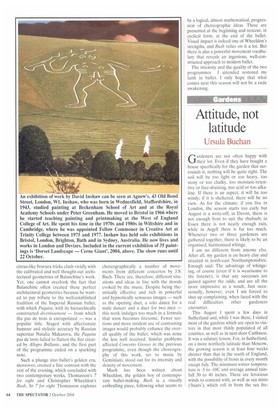Californian class
Giannandrea Poesio
San Francisco Ballet Sadler's Wells Theatre
T wish ballet companies due to visit 1 London in the next few months could bring programmes that are as richly varied and neatly constructed as those presented by San Francisco Ballet last week. Artistic eclecticism as well as the ability to respond to a diversity of stylistic and technical demands are two of its most noticeable qualities. This 69-strong company, under the 20-year directorship of Helgi Thomasson, has matured into one of the best companies today.
I do not recall the last time I saw such an impeccable rendition of George Balanchine's The Four Temperaments, the crowning glory of the second programme. The complex intricacies of the dance phrasing, the subtle choreographic chiaroscuros and the rarefied atmosphere of this plotless, somewhat modernist and neoclassical 1946 work are not easy to come to terms with, 21 years after the death of its creator. Yet every artist on stage seemed to be perfectly at ease with the interpretative and technical demands of the ballet, thus revealing a rare understanding of Balanchine's art.
And it was not just an isolated case, for the same evening started with an equally memorable performance of Ballo della Regina. Set to Verdi's flamboyant, catchy music for the ballet in Don Carlos, the 1978 creation is a jollier, more carefree piece than The Four Temperaments, even though it is equally tricky and demanding. In line with the original theme of the opera ballet, it contains a number of 'underwater' movements, including 'swimming' and fish-like gestures that can easily slip into the ridiculous when badly performed and misunderstood. Luckily, the artistic sensibility of the San Francisco Ballet dancers overcame such a risk, bringing to the fore the brilliance and ingenuity of the ballet.
Sheer pleasure was also elicited, the following night, by the performance of Balanchine's Allegro Brillante, which opened the third programme, arguably the most intense and varied of the three. At first, to have the old Paquita pas de trois follow Allegro Briltante did not seem a good idea. After all, Paquita is the epitome of that tad' old 19th-century ballet taste we all like to indulge in now and then. Its phony Spanish colour and flavour, its endless series of purely virtuoso and somewhat circus-like bravura tricks clash vividly with the calibrated and well thought-out architectural geometries of Balanchine's work. Yet, one cannot overlook the fact that Balanchine often created these perfect architectural geometries because he wanted to pay tribute to the well-established tradition of the Imperial Russian ballet, with which Paquita, with its hierarchically constructed divertissement — from which the pas de trois is extrapolated — was a popular title. Staged with affectionate humour and stylistic accuracy by Russian superstar Natalia Makarova, the Paquita pas de trois failed to flatten the fizz created by Allegro Brillante, and the first part of the programme ended on a sparkling note.
Such a plunge into ballet's golden era, moreover, created a fine contrast with the rest of the evening, which concluded with two contemporary works, Thomasson's 7 for eight and Christopher Wheeldon's Rush. In 7 for eight Thomasson explores choreographically a number of movements from different concertos by J.S. Bach. There are, therefore, different situations and ideas in line with the moods evoked by the music. Despite being theatrically effective and rich in powerful and hypnotically sensuous images — such as the opening duet, a solo dance for a male dancer and a duet for two men — this work indulges too much in a formula that soon becomes tiresome. Fewer sections and more strident use of contrasting images would probably enhance the overall quality of the ballet, which was none the less well received. Similar problems affected Concerto Grosso in the previous programme, even though the choreography of this work, set to music by Geminiani, stood out for its intensity and density of movement.
Much has been written about Wheeldon, the golden boy of contemporary ballet-making. Rush is a visually enthralling piece, following what seems to be a logical, almost mathematical, progression of choreographic ideas. These are presented at the beginning and reoccur, in cyclical form, at the end of the ballet. Visual impact is indeed one of Wheeldon's strengths, and Rush relies on it a lot. But there is also a powerful movement vocabulary that reveals an ingenious, well-constructed approach to modern ballet.
The intensity and the quality of the two programmes I attended restored my faith in ballet. I only hope that what comes next this season will not be a rude awakening.



















































































 Previous page
Previous page